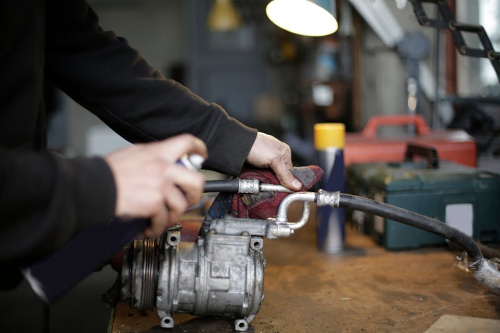
About motor winding, let me take you on a journey where you discover the magnificence of precision and modernity that make up the whole art of making electric motors. An extensive set of meaningful items, including the motor winding machines, do not apply to the industry and are consumed by it. When it comes to this, what precisely do motor winding equipment consist of, and why are they vital? Let us decode the magic they wear and understand their significance in enhancing accuracy, time-saving, and readability in electric motor making.
Beginning with coil winding machines and ending with insulation equipment, we will examine the most prevalent features and recent tendencies that will control the manufacturing of motors in the future. Join me as we start learning how to wind motors using the basic machinery and tools from the introduction.
What is motor winding equipment?
The motor winding hardware is a representative name for tools and devices intended to wind the wire coils around the magnetic cores by forming the windings within the electric motors. This equipment guarantees smooth, error-free production of the rotor and the stator of different size levels and types.
Which kind of Motor winding equipment is used in Motors?
Coil winding machines:
Automated machines wind wire coils around magnetic cores with precision and consistency.
Tensioning devices:
Tools or mechanisms to maintain proper tension on the wire during winding, ensuring uniform winding patterns and preventing slack.
Wire guiding systems:
Systems designed to guide the wire onto the core during winding to ensure accurate placement and prevent tangling.
Insulation and varnishing equipment:
Machinery and tools used to apply insulation materials and protective coatings to the windings for durability and electrical insulation.
Coil forming and shaping tools:
According to motor design specifications, tools are used to shape wire coils into desired configurations, such as concentric or distributed windings.
Testing and quality control instruments:
Instruments for assessing windings’ integrity, electrical properties, and performance to ensure they meet required standards and specifications.
Why is motor winding equipment essential?

The importance of motor winding equipment lies in its essential function within the production system of electrical motors. Here are numerous key motives why the motor winding system is crucial:
Precision and Consistency:
The motor winding system ensures specific and consistent coils winding around magnetic cores, leading to uniform winding styles and dependable motor overall performance.
Efficiency:
Automated winding machines increase efficiency by speeding up the winding method and lowering labor requirements, ensuring better productivity and decreasing production costs.
Quality Control:
Motor winding equipment includes trying out delicate control gadgets to evaluate the integrity and performance of windings, ensuring that cars meet required standards and specs.
Customization:
With diverse winding machines and gear, motor winding equipment customizes winding configurations to fulfill unique motor layout necessities and packages.
Durability and Reliability:
Insulation and varnishing systems assist in applying shielding coatings to the windings, improving their durability and electrical insulation residences and enhancing motor reliability and sturdiness.
Innovation and Advancement:
Ongoing improvements in motor winding gadget generation enable manufacturers to innovate and improve motor designs, leading to more excellent performance, efficiency, and functionality.
Overall, motor winding equipment performs a crucial function in producing brilliant electric cars, ensuring precision, efficiency, and reliability of their creation and performance.
Emerging trends in motor winding equipment
Emerging trends in motor winding devices are revolutionizing electric motor production. Automation and robotics are increasingly included to enhance precision and scalability, streamlining the winding technique. Advanced materials and coatings enhance sturdiness and overall performance, while digitalization and connectivity features permit actual-time monitoring and predictive renovation. Additive manufacturing technologies like 3-D printing provide flexibility and cost-effectiveness in generating custom additives.
Sustainable practices are also gaining traction, aligning with global efforts towards environmental responsibility. Industry 4.0 integration drives innovative manufacturing practices, optimizing processes and improving efficiency. Lastly, modular and flexible designs allow for adaptability to diverse production needs. These trends collectively propel innovation, efficiency, and sustainability in motor winding equipment, shaping the future of electric motor manufacturing.
Considerations when Choosing Motor Winding Equipment
Ensure equipment offers precise control over winding tension, wire placement, and coil formation for uniform winding patterns and consistent quality. Choose equipment that accommodates various motor sizes, configurations, and production requirements to adapt to changing market demands.
Invest in Motor winding equipment with features like robotic integration and virtual controls to beautify productiveness and reduce labor costs. Select devices made of remarkable substances designed for clean maintenance to limit downtime and ensure long-term reliability. Consider the overall value of ownership, initial funding, operating expenses, and potential return on investment to make a financially sound selection.
Conclusion:
Ultimately, the end game is the capability and knowledge to make motor winding phenomenal through the comprehension of vital system components and devices, accompanied by understanding dynamic trends and critical factors. Electric motor manufacturing relies on many devices, including coil winding machines, insulation equipment, etc. All these devices are essential to the process as they control the precision, efficiency, and reliability of manufacturing. By adopting innovations and motor winding technology developments, motor manufacturing entities can boost performance, efficiency, and functionality, enabling them to meet dynamic industrial and application needs. In the turbulent environment of motor winding, against the backdrop of these phenomena, the consistency of sustainable processes, integration of the new school of industry, and the value of modularity and flexibility should be kept in mind.


